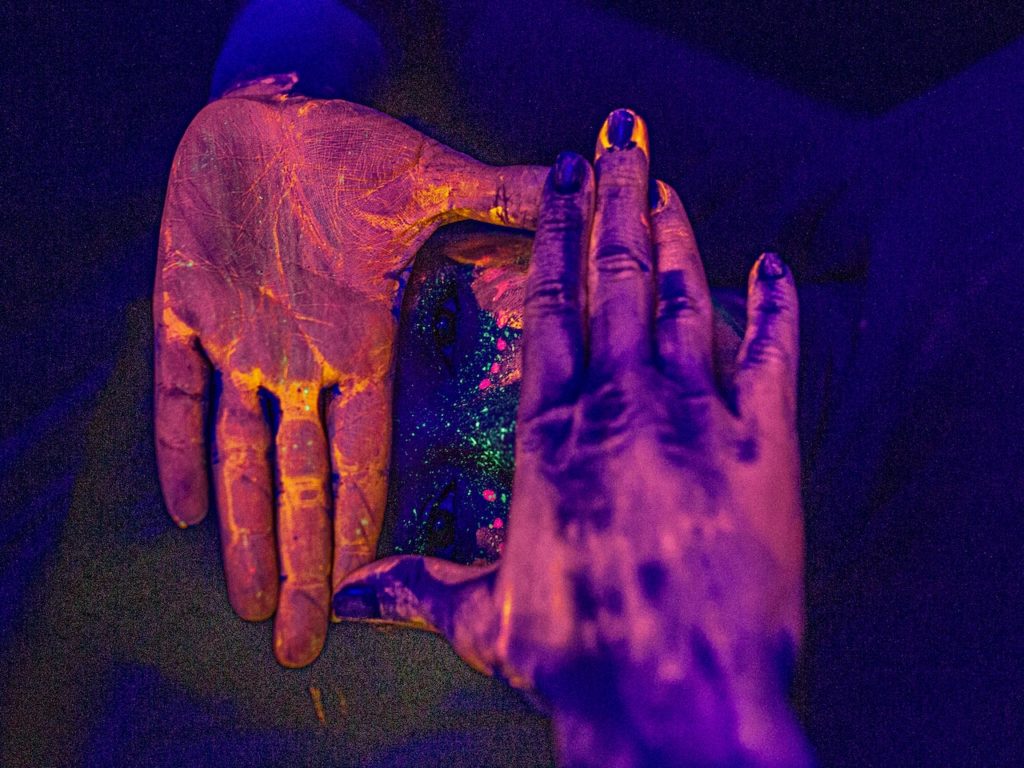
Why does blood show up under UV light? Because it absorbs all of the light and appears completely black. When we watch crime movies, the police often use a black light to show stains at the murder scene. Well, a black light will make many bodily fluids glow, but it won’t make blood glow.
Ultraviolet light is electromagnetic radiation that has a wavelength of between 350 nm and 10 nm. Electromagnetic radiation is produced when an atom absorbs energy. This energy makes the electrons around the atom jump to a higher orbit. Electrons really like being at their natural orbit, so they try to lose this energy as quickly as possible. When they lose that energy, it is given off as electromagnetic radiation. The biggest source of electromagnetic radiation for us is the sun. The sun has so much mass that the massive pressure inside it fuses four hydrogen molecules together to make one helium molecule. This process produces energy because the weight of four hydrogen molecules is slightly higher than the weight of one helium molecule and mass equals energy. This energy is transferred through the atoms in the sun until it reaches the edge and flies out into space.
Electromagnetic radiation has a lot of different amounts of energy. When it has a lot of energy, it has a very high frequency because the waves are very close together. When it has less energy, it has a very low frequency because the waves are very far apart. At the top end, with the most energy, we have gamma radiation, with a wavelength of 0.0001 nm to 0.001 nm. Then x-rays with a wavelength of 0.001 nm to 10 nm. Then ultraviolet light, with a wavelength of 100 to 400 nm. Then visible light with a wavelength of 400 to 700 nm. Then infrared with a wavelength of 700 to 1000 nm. Then microwaves with a wavelength of 1000 nm to 30 cm. And, last, radio waves, with a wavelength of 30 cm to 100 km. The different amounts of energy and the length of the wavelengths mean each type of wave has different properties and can be useful for different things.
Why do some things glow under UV light? UV lights can be produced by something called a black light. This produces light in the same way as a light bulb does, but the light bulb has a filter around it to trap all of the light with longer wavelengths and only release the light with shorter wavelengths, which is the UV light. This has far more energy and is a part of the electromagnetic spectrum that is invisible to us. Some fluorescent substances called phosphors absorb this energy. The electrons around their molecules jump to another orbit and then they release the energy. When they release it, they give off energy in the form of light photons, but they have a slightly longer wavelength and are now in the visible part of the electromagnetic spectrum that we can see. This makes them glow. Many countries put phosphors in the material they use to make their money so that it will glow under a UV light. This is one way to check if the money is counterfeit.
In crime shows on TV, we often see them using a black light to make the blood stains glow visibly. Well, blood stains don’t actually glow under UV light. Other bodily fluids do glow because many of our bodily fluids contain phosphors. At a murder scene, a black light could be used to reveal a lot of bodily fluids. Blood, however, does not glow. When exposed to a black light, blood shows up as black. The molecules in the blood absorb all of the energy from the black light and none is released. This does make it possible to see the blood, though, because other materials will reflect some of the UV light and the blood will be the only part that is completely black. This gives some contrast and makes it easier to see. If the police are looking for blood on a dark red surface, or if the blood stain has faded, they won’t be able to see it with the naked eye, but a black light will give enough contrast to make it out. It is even possible to detect a blood stain that has been painted over because the UV light can pass through the paint.
It is possible to make blood glow. At a crime scene, the police can spray the blood with a chemical called luminol. This chemical reacts with the iron in the blood and emits a blue glow that can be seen if the room is dark. It can also be photographed. And this is what I learned today.
Photo by Lucas Pezeta: https://www.pexels.com/photo/anonymous-woman-with-painted-hands-in-neon-light-4336968/
Sources
https://www.livescience.com/50326-what-is-ultraviolet-light.html
https://www.physicsforums.com/threads/finding-blood-with-uv-light.388224/
https://en.wikipedia.org/wiki/Luminol
https://www.qrg.northwestern.edu/projects/vss/docs/thermal/3-what-makes-em-radiation.html
https://www.ces.fau.edu/nasa/module-2/radiation-sun.php
https://wonderopolis.org/wonder/why-does-a-black-light-make-things-glow
https://www.advancedndt.co.uk/post/uv-light-in-forensics-crime-scene-investigation
https://www.glogerm.com/pdf/Crime_blood.pdf
https://www.chemistryworld.com/news/blood-will-out/3007543.article

Pingback: What are moles, freckles, and birthmarks? | I Learned This Today